
Celebrate ten years of Urban Omnibus and support ten more years of fresh, independent perspectives on citymaking with a donation today!
Celebrate ten years of Urban Omnibus and support ten more years of fresh, independent perspectives on citymaking with a donation today!
When the Lambert Houses were completed in 1973 as part of the Bronx Park South Urban Renewal Area, the complex was quickly recognized as a significant architectural and social contribution. Built by nonprofit affordable housing developer Phipps Houses (which still owns and operates Lambert today) and designed by Davis, Brody and Associates (now Davis Brody Bond), the cluster of low-rise, six-story buildings was celebrated for its architectural design and sensitivity to its West Farms neighborhood. On-site provision of social services further cemented the progressive credentials of the development.
So when UO columnist Susanne Schindler learned that Phipps is planning to demolish and redevelop the Houses, citing structural issues and significant security concerns, she wanted to understand what went wrong at this much-lauded site. As she traces the architectural, social, and economic factors that took Lambert from acclaim to pending demolition and redevelopment, Schindler confronts the intersection of historical preservation and housing provision. In so doing, she questions why New York City’s diverse and innovative history of affordable housing design is so often unrecognized as important to our cultural heritage and argues for preservation — both architectural and financial — of our affordable housing stock.
–V.S.
This is not a plea to save the Lambert Houses. What would give me the right to demand such a thing? I know little about their financial situation, their structural integrity, or what it’s like to live inside. Nonetheless, I will ask a series of questions prompted by my initial reaction (of dismay, I admit) when I heard that this cluster of exceptionally designed low-income housing is soon to be “redeveloped,” that is, will soon be gone.
Located in the West Farms neighborhood of the Bronx and abutting the Zoo, the Lambert Houses are as striking from up close as they are from a remove, which is how I first spotted the series of orange-red-ish structures from the elevated number 2 train. My eyes tried to identify what I was seeing: clearly it was housing, marked by unusually jagged façades rising slightly higher than their neighbors’ yet loosely forming perimeter blocks. The irregularly reflecting and sparkling windows at the façades’ folds brought the complex to life. I had no idea what this was, other than thinking, “quite beautiful.” When I proceeded to walk through the buildings, down 180th Street then along Boston Road and other streets, I was again struck by their scale and detail despite the addition of a stucco envelope over an original, much finer-grained brick façade. There was something friendly about these buildings, and I wanted to know more.
In New York 1960, Robert Stern, Tom Mellins, and David Fishman describe the six-story, 731-unit project sited on five blocks of the Bronx Park South Urban Renewal Area as “arguably the era’s most contextually responsive, high-density, low-rise housing project.”[1] Its origins are unique: a group of neighbors organized to develop new housing for an area rapidly losing population and investment, but unable to do so themselves partnered with Phipps Houses, a non-profit developer that still owns and manages Lambert Houses. Stern et. al. situate the resulting design, by Davis, Brody and Associates, in the legacy of the 1920s garden-type apartments in Queens. In A History of Housing in New York City, Richard Plunz positions the project, which was completed in 1973, as “directly derivative of the perimeter block tradition” and concludes: “At the moment of the crisis with the tower, when the tower was pushed to its formal limits in an effort to reduce scale and to increase responsiveness to context, there also was the beginning of a historicist tendency which rejected the tower completely.”[2] Clearly, Lambert Houses marks a turning point in the history of New York City housing and its relation to the city.
Journalists agreed: Ada Louise Huxtable was enthusiastic about Davis, Brody’s approach, titling an overview of the firm’s many urban projects — from the early Riverbend housing in Harlem, to Waterside Plaza in Midtown and Harlem River Houses in the Bronx — “Breaking The Mold” and closing with a characterization of the designs as “a human, esthetic and environmental fusion that has been notably lacking in New York.”[3] Architectural Record titled its ten-page review of the completed project just as unequivocally: “Urban Renewal with a Conscience.”[4]
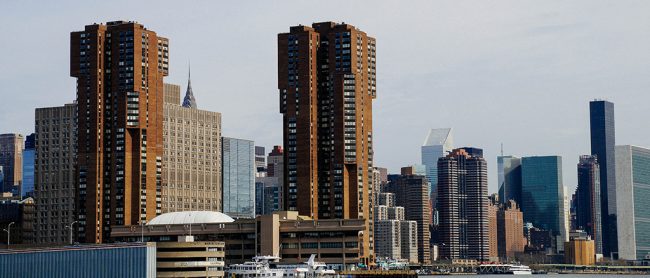
Davis, Brody, and Associates’ Waterside Plaza in Midtown | Photo by Jeffrey Zeldman
We know that the architectural press’ enthusiasm for a just-completed, not-yet-lived-in project tells an incomplete story, and that historians are often focused on constructing larger narratives at the expense of the details, but there is published evidence that this project was later considered a success as well. On the occasion of Lambert Houses’ ten-year anniversary, the New York Times Sunday Real Estate section called it “The project that transformed a Bronx neighborhood,” and described the development, which had received an award from the New York Society of Architects, and its vast array of social and educational services as “a stabilizing force in a troubled community.”[5]
So yes, my initial reaction to hearing about the buildings’ impending demolition was one of dismay. Why do these buildings, which mark a key moment in New York City’s architectural trajectory and stand out to uninformed passers-by today, have to go? Does no one else see the value that I think I see here?

(L) Aerial of Lambert Houses and (R) Lambert Houses upon realization | Images courtesy of Davis Brody Bond
When I spoke with Phipps Houses CEO Adam Weinstein, he seemed genuinely surprised to hear that I found the Lambert Houses friendly — he has always considered the buildings threatening. Rectifying the buildings’ security problems is one of the main reasons Phipps is pursuing redevelopment, along with the estimated high cost of further physical rehabilitation and the potential to more than double the number of apartments under current zoning through redevelopment of the site. Weinstein emphasized that he, too, shared an interest in and grappled with the urban renewal era of the 1970s, since many projects, such as Lambert, were “built according to the best planning practices of its day.” But he underlined that thinking evolves and that we need to reevaluate. He sums up “well-intentioned” Lambert as being the victim of “wrong financing, wrong planning, wrong plumbing, wrong architecture. But otherwise it’s a perfect project.”
Weinstein’s primary critique was not the buildings’ structural issues, in particular that of the façades, which have created major cost and logistical problems in the past, but that the buildings have “no ability to secure themselves.” He explains by pointing to two planning decisions. The first are the courtyards. Intended to be visually and physically open to the general public and create ample usable open space, they can still, save for those areas now fenced in, be entered by anyone, leading to misuse for drug trading or other unwelcome activities. The second is the decision to “gang buildings around egress stairs.” A plan filed at the Department of Buildings reveals the problem clearly. While the structure covering an entire city block is broken down visually into many parts and may have four or more distinct entrances, the stairs, acting like joints between these staggered building sections, function as the means of egress for both adjacent building sections. This creates one large building, linked internally through the double-loaded corridors on every floor. Keeping track of who is coming and going is made very difficult.
How did something so well-intentioned seemingly turn so wrong? How did many of the project’s originally celebrated features — the open space, the community spaces within — turn into liabilities so that even apparent benefits, such as the range of unit sizes and duplex apartments are no longer considered valuable? Was it the architecture, the residents, or the poor construction?
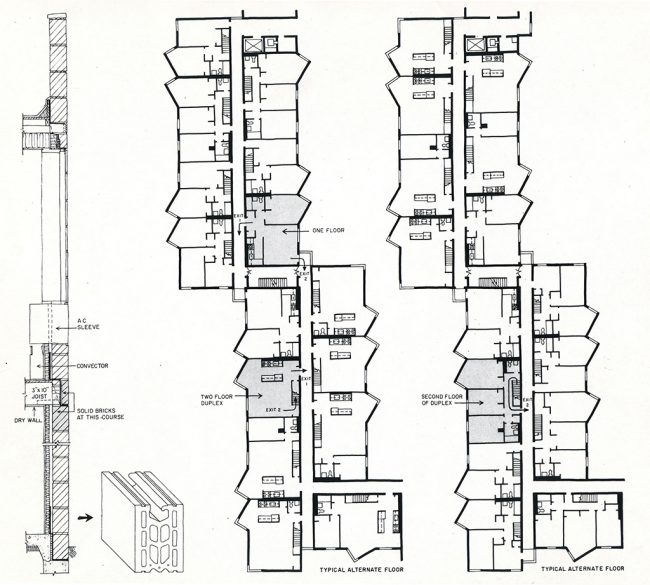
Detail of wall section and typical floor plan for Lambert Houses | Image courtesy of Davis Brody Bond
Some clues are chronicled in a 1997 article by Lynda Simmons, part of Phipps Houses from 1969 to 1983, ten years as its director.[6] Simmons writes that only a few years after completion, structural defects lead to 14 years of legal battles with the contractor to win money for repairs. This, combined with rising heating costs (a post-oil crisis issue for many housing operators); shifting federal support for low-income housing (which turned the project from moderate to low-income through the Section 8 support); and a continuously declining neighborhood made the project a site of many problems. As Simmons writes, these crises, which plagued neighborhoods throughout New York City but were particularly prevalent in West Farms, prompted Phipps to shift its mission “from building low-income housing to building communities,” that is, providing the supportive services necessary to succeed, be those educational, psychological, leisure, or health services. I spoke briefly with Simmons, now retired and living in North Carolina, by phone. She had not heard of the plans to demolish the buildings but was quick to say that they had “enormous design problems from the start, which led to criminal and anti-social behavior.” She did not elaborate further.[7]
At Davis Brody Bond, the successor firm to Davis, Brody and Associates, the institutional memory of Lambert was contained in four boxes brought in from deep storage.[8] They contained two key finds: the documentation of two earlier schemes for the project: one a high-rise scheme, which leaves Bryant Avenue in place, and the other a mid-rise version, similar to the urban design as realized with the key difference that the building mass is broken down into separate, side-by-side buildings, each organized around one central core with two stairways. Why this version, which would have avoided the “ganging” problem, wasn’t realized, others will have to find out; most likely it was a hoped-for “efficiency” promised by saving on the number of stairways.
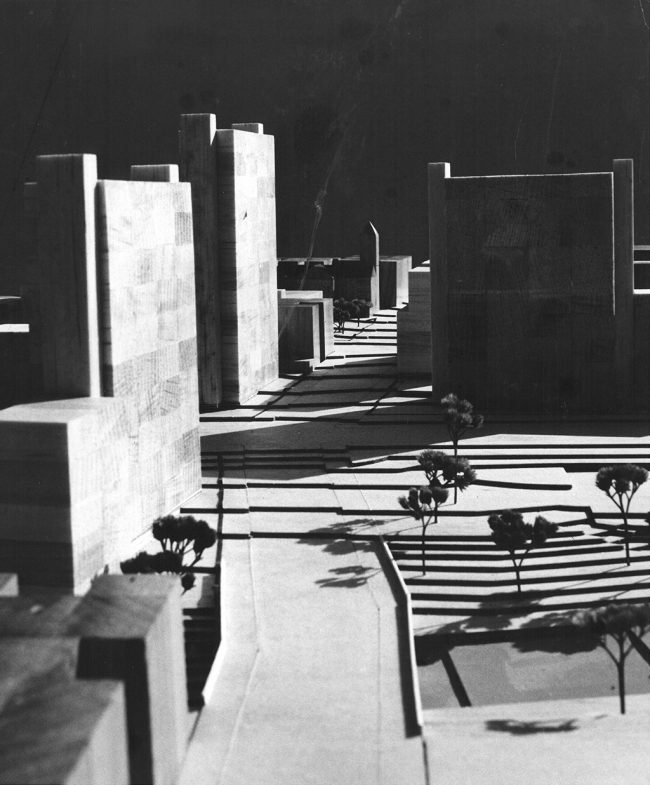
Model of early mid-rise Lambert Houses plan that maintains separate, side-by-side buildings| Photo courtesy of Davis Brody Bond
As to the structural issues with the façade, it is unclear whether the fault lay with Davis, Brody’s design or with how it was implemented. The architects custom designed an 8 x 8 load-bearing masonry brick to bring the project within tight budgetary constraints. According to a 1970 article, written while the Lambert Houses were still in design development and referencing the tight budgetary situation of housing throughout the country, “load-bearing masonry construction was the only system that would meet present mortgage limits. Since the building code now allows bearing-wall thickness to be determined by calculation [performance-based], it was possible to erect 8-in. exterior walls and 6-in. corridor walls for the six-story buildings.”[9] The brick was considered an innovation, and the masonry became the firm’s trademark for a time.
Tax records show that Phipps satisfied the mortgage for the Lambert Houses in December of 2014, making the property debt- and obligation free. Its Section 8 contract expired in June of 2014, meaning these subsidies would have to be renegotiated — a mere formality according to some experts. This also means, at least theoretically, that Lambert Houses could be sold and allowed to go market rate.
Instead, Phipps is planning to replace the buildings, and their proposal is hard to argue with. In fact, the plan’s audacity in aggressively advocating for the creation of low-income housing should be a model for others. The goal, as outlined by Weinstein and yet to be financed, is to add roughly 1,000 units of housing to the current count of 731 and make them 100 percent affordable in perpetuity. The income mix will likely be limited to 60 percent AMI, the highest level the Low-Income Housing Tax Credit allows. The higher density is based on a yet to be approved reversion of the current FAR of 1.8, as prescribed by the urban renewal general plan for Lambert sites, to an FAR of roughly 4 allowed by the current R7-1 zoning. To remedy what are considered the weaknesses in Davis, Brody’s design, Phipps intends to reconnect the streets which were de-mapped in 1969 (but maintained as pedestrian walkways through easements); build up to the street edges; locate community or commercial uses on ground floors, primarily along Boston Road and 180th Street; and build higher adjacent to wider streets or open space and lower on interior streets. Weinstein calls the goal of creating viewscapes and ample open space for residents “ideas worth preserving” from the original scheme. The redevelopment would be implemented in phases so as not to displace any residents from the complex.
Official meetings between Phipps, relevant agencies, and other stakeholders have just begun. Ted Weinstein, director of planning for the Bronx for the City’s Department of Housing Preservation and Development (with no relation to Phipps CEO Adam Weinstein), noted with some caution that “it’s unusual, it’s large” and “hopefully it will be replaced by something better, easier to manage — a contribution to the neighborhood.” Wilhelm Ronda, director of planning and development at the Bronx Borough President’s Office, welcomes the proposal, even if he would like to see higher income limits. “If anyone can do this,” he said, “it’s Phipps.” The Housing and Land Use Committee of Community Board 6 will complete a formal review of the project during the NYC Environmental Review Process later this year. Hannah Fleisher, a Community Planning Fellow at CB6, feels there is a potential for positive outcomes, pending further consultation with the residents (two of whom sit on the community board) and wider community.
To put Lambert into perspective, I spoke to several housing experts familiar with affordable housing development in New York City. They all confirmed that it is highly unusual for an income-restricted, publicly subsidized development to be demolished. Indeed, in the nation’s HOPE VI-induced enthusiasm to rid us of high-rise public housing, the only instance where New York joined the party is with Prospect Plaza, three towers in Brownsville, demolished in 2014.[10] But even more generally, in affordable, non-public housing, there has not been any other demolition of existing structures, no matter their architectural merit, in the past 15 years. To make the point, a senior housing official in the Bloomberg administration, while reluctant to assess a plan he was unfamiliar with, did point to the recent refinancing, rehabilitation, and reimagining of Ocean Village in Rockaway to make the point that the plan to redevelop Lambert represents a very rare case.[11]
And so, the case of the Lambert Houses prompts a broader question. In the current conversation on how to increase the availability of housing affordable to everyone from low- to middle-class households in New York City, the numeric emphasis is not on new construction, but on the preservation of existing income-restricted or rent-regulated housing. Where does this “affordability” meaning of the word preservation intersect with the meaning that pertains to our architectural history? Phipps is answering that question numerically: it aims to provide more, and better, housing through a new project. But stepping back for a moment, it remains important to ask: why is low- and moderate-income housing not considered to be an important expression of our cultural heritage? At what point, and for what reasons, would the public interest in preserving that cultural heritage trump the owner’s interest, whether that is economic or otherwise, in that property?
To be considered eligible for the status of an “individual landmark,” the City’s Landmark Preservation Commission states that the building must be “at least 30 years old and have a special character or special historical or aesthetic interest or value as part of the development, heritage, or cultural characteristics of the City, state, or nation.”[12]
The only low- and moderate-income housing currently landmarked in New York City is all pre-1939.[13] The kinder low-rise pre-war makes it in, while the post-war seems stuck in an “evil tower-in-the-park urban renewal” image despite its diversity of program and typology manifested by projects such as Lambert. There are landmarked districts, to which the Lower Grand Concourse is one of the most recent additions, but none of the exceptional projects realized between the mid-1960s and mid-1970s — in which I would count Davis, Brody’s Riverbend (1966), the UDC’s Twin Parks with buildings by Richard Meier, Prentice and Chan, Ohlhausen, and others (1967-74), or Josep Lluís Sert’s Roosevelt Island (1971-76) — make it in.
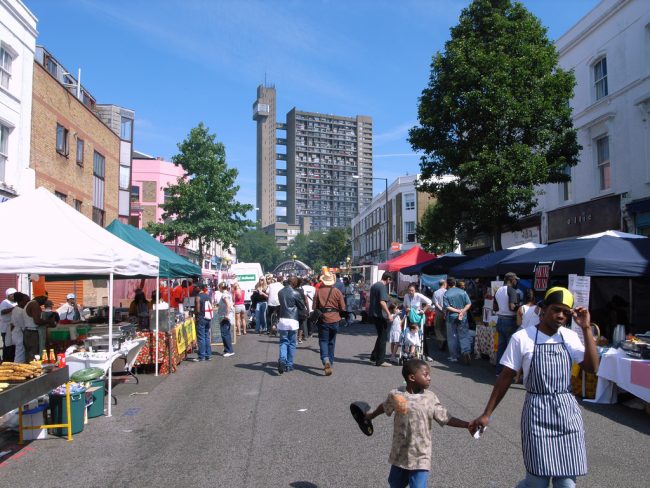
Ernő Goldfinger’s Trellick Tower in London | Photo by Steve Cadman
When I spoke to Mary Beth Betts, head of research at the City’s Landmarks Preservation Commission, she had not heard of any initiative or even conversation around landmarking housing of this era. This is astonishing given the sheer numbers and contribution of post-war housing to the city’s character. Most post-war housing is not as ornate or solidly constructed as 19th-century brownstones and is, in contrast, rather bare thanks to the limited budget it had to contend with. But even if we don’t agree on aesthetics, can we not agree on the central, historic role of housing in shaping our notions of citizenship and civic identity? Can we not agree that these notions have evolved and continue to evolve? If we aren’t aware of the past’s attempted solutions to house people of all income levels, how can we position what we are doing today?
This lack of awareness of what post-war modern housing not only was, but what it could be, stands in surprising contrast to other cities, where living in former publicly owned housing complexes, often previously considered failures, has become highly sought-after. That our perception and experience of architecture can rapidly change was laid out beautifully in a recent article by Fosco Lucarelli and Mariabruna Fabrizi on the fate of Ernö Goldfinger’s Trellick Tower in London, a Brutalist high-rise which went, as the authors write, from being the “tower of terror” to now bringing “street cred” to its residents in an otherwise rapidly gentrifying neighborhood.[14] Even in Chicago, a city not exactly known for its embrace of post-war public housing, a decidedly futurist 1960s project was landmarked in 1999: Bertrand Goldberg’s Hilliard Homes, an ensemble of curved high-rises and point towers realized with prefabricated concrete panels in 1966, the peripheral sibling of the better known middle-income, center-city Marina City towers.[15]
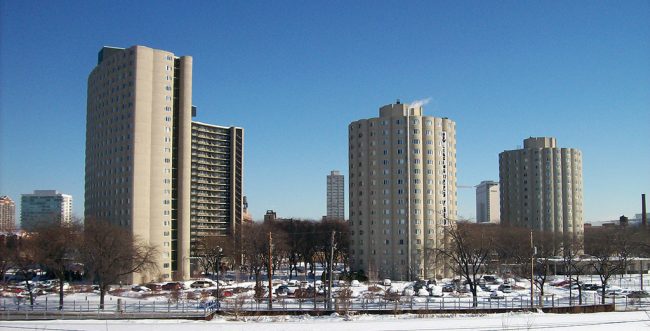
Bertrand Goldberg’s Hilliard Homes in Chicago | Photo by John Iwanski
To be clear: I am not advocating for the historization or musealization of the Lambert Houses. Buildings are there to be used, lived in, worked in, extended, shrunk, appropriated. But I am shocked by our lack of knowledge about and disregard for — even embarrassment with — the recent past. Looking at the trajectories of the Trellick Tower in London or the Hilliard Homes in Chicago, I am additionally weary that to preserve modern housing, the only path seems to be to lift its income- and rent-restrictions on at least a substantial number of the apartments. The case of Lambert is slightly different. Phipps’s aggressive and ambitious socio-economic proposition — to replace the buildings with more than double the current number of apartments, all reserved for low-income households in perpetuity — easily trumps any argument pertaining to their historic importance or possible objection based on fears of displacement.
We’re left with three questions that reach beyond Lambert: Are we capable of imagining a future for the built realities of the visionary low- and moderate-income housing of the 1960s and 1970s, other than to deregulate and privatize? What would it take not only in terms of financial, but in terms of design and management creativity, to let the original promises of the rooftop community rooms, the ground-floor childcare spaces, or the outdoor sitting areas come alive again? If a non-profit of the scale and clout of Phipps, with its unusually long and varied history of realizing new housing design integrated with supportive services, can’t or doesn’t want to do it, which stakeholders do need to become active?
We will soon learn more about the redevelopment proposal for Lambert Houses. Let it be a prompt to debate these questions, even if the redevelopment of Lambert seems a foregone conclusion.
NOTES:
[1] Robert Stern, Tom Mellins, and David Fishman, New York 1960, New York: Monacelli 1995: 961.
[2] Richard Plunz, A History of Housing in New York City, New York: Columbia University Press, 1990: 304.
[3] Ada Louise Huxtable, “Breaking the Mold,” New York Times, February 10, 1974. A slightly earlier article on Davis, Brody’s work used the same expression: Stanley Abercrombie, “New York Housing Breaks the Mold,” Architecture plus, January 1974: 62–89.
[4] Charles Hoyt, “Urban Renewal with a Conscience,” Architectural Record, January 1974: 133–140.
[5] Stephen Daly, “The project that transformed a Bronx neighborhood,” New York Times, May 15, 1983.
[6] Lynda Simmons, “Twenty-Five Years of Community Building in the South Bronx: Phipps Houses in West Farms,” in: Affordable Housing and Urban Redevelopment in the United States, edited by Willem van Vliet. Thousand Oaks, CA: Sage, 1997, pp. 73–94.
[7] Lynda Simmons’ contribution to New York City housing is a story waiting to be written. Educated as an architect at Cooper Union, Simmons worked on Riverbend while at Davis, Brody, joining Phipps after the firm had been commissioned with Lambert Houses. She built the organization to 500 staff members, and 3,500 apartments. For a sense of the housing debate in the mid-1980s, see the collection of essays edited by Eugenie Ladner Birch, The Unsheltered Woman (1984), re-issued in 2012 by Transaction Press. In it, see Lynda Simmons, Carol Lamberg, and Linda Field, “Theory and Practice of Housing Development: Changing the Physical Environment of Our Lives.”
[8] The original partners, Samuel Brody and Lewis Davis, passed away in 1992 and 2006 respectively. Steven Davis, Lewis’s son and current partner, worked on Lambert only briefly. Thanks go to Elizabeth Frenchman and Christey Robinson for enabling access to these records.
[9] Stephen Kurtz, “Toward and Urban Vernacular,” Progressive Architecture, July 1970: 104.
[10] HOPE VI also funded the redevelopment of a low-rise public housing complex Markham Gardens in Staten Island.
[11] Located in Far Rockaway, this Mitchell-Lama rental project, designed by concrete-prefabrication pioneer Carl Koch, was completed in the mid-1970s. The 1,094-unit high- and low-rise project had deteriorated physically and socially. The buildings were wrapped in EIFS insulation and visually spruced up; their affordability was secured through property tax relief. Laura Kusisto, “New Fund Will Buy and Renovate Buildings for Low- or Middle-Income Residents,” Wall Street Journal, June 3, 2013.
[12] New York City Landmarks Preservation Commission, “Landmark Types and Criteria,” accessed March 17, 2015.
[13] The Dunbar Apartments, Harlem, sponsored by John D. Rockefeller specifically for African-Americans (completed 1928; New York City Landmark Preservation Commission designation (LPC): 1970; National Register of Historic Places (NRHP): 1979); First Houses, the first public housing in NYC (1935; LPC: 1974); Harlem River Houses, among the first federally-funded public housing projects (1937; LPC: 1975, NRHP: 1979); and its “whites-only” counterpart, Williamsburg Houses (1938; LPC: 2003).
[14] Fosco Lucarelli and Mariabruna Fabrizi, “The Trellick Tower: Rise and Fall of a Modern Monument,” San Rocco Magazine #5, Fall 2012 [Scary Architects]. Also worth reading are the following articles on the long debate over the fate of London’s Robin Hood Gardens: Will Hurst, “Shock Bid to Save Robin Hood Gardens,” Architects Journal, March 17, 2015. And Justin McQuirk, “Their Rented Bit of the Socialist Dream,” in SQM: The Quantified Home, edited by Space Caviar, Zurich: Lars Müller, 2014.
[15] BertrandGoldberg.org on the Raymond Hilliard Homes, accessed March 17, 2015.
The views expressed here are those of the authors only and do not reflect the position of The Architectural League of New York.
Comments